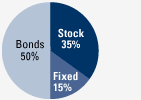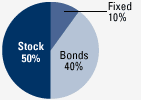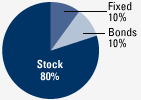Asset allocation is the process of dividing your money among stocks, bonds, and cash equivalents according to a conservative, moderate, or aggressive strategy.
This process should also result in an overall diversified portfolio, which can help manage risk. These charts show four examples of asset allocation, which vary according to the investors' ages, time horizon, and risk tolerance.
| |
 |
|
|
| Joe and Eileen have recently retired. As
investors, they are comfortable with a degree of risk that enables them
to seek a moderate return. They want 35% of their money in stock subaccounts
to maintain some growth potential for the 20 to 30 years they expect to
live in retirement. They hold 15% in a short term, fixed-rate option, and
50% in bond sub-accounts, which are generally more stable than stocks. |
| |
|
|
|
| |
 |
|
|
| Kim and Joel have about 10 years until retirement. They wouldn't feel comfortable with broad fluctuations in the value of their investments, so they've invested 40% of their annuity contract in bond subaccounts for relative stability and another 10% in a fixed-rate interest option. They've invested the remaining half of their annuity contract in stocks, hoping to use time and tax deferral to their advantage. |
| |
|
|
|
| |
 |
|
|
| Susan has just finished paying
her daughter's college expenses and wants to catch up with her retirement
goals. She has more than 20 years until retirement. Because she has a rather
long investment time frame, she feels comfortable putting most of her money
into stocks (80%), which may provide the greatest growth potential, though
they may fluctuate in value. |
| |
|
|
|
| |
 |
|
|
| David has just started his career
and seeks maximum capital appreciation. Because retirement is 35 or more
years away, he has a high risk tolerance and is comfortable investing 100%
of his annuity in stocks. |
| |
|
|
|
The asset allocation models above are hypothetical, and are not meant to illustrate any particular investment style. A licensed financial professional can work with you to construct a portfolio that suits your individual retirement needs, investment time horizon, and risk tolerance.
|